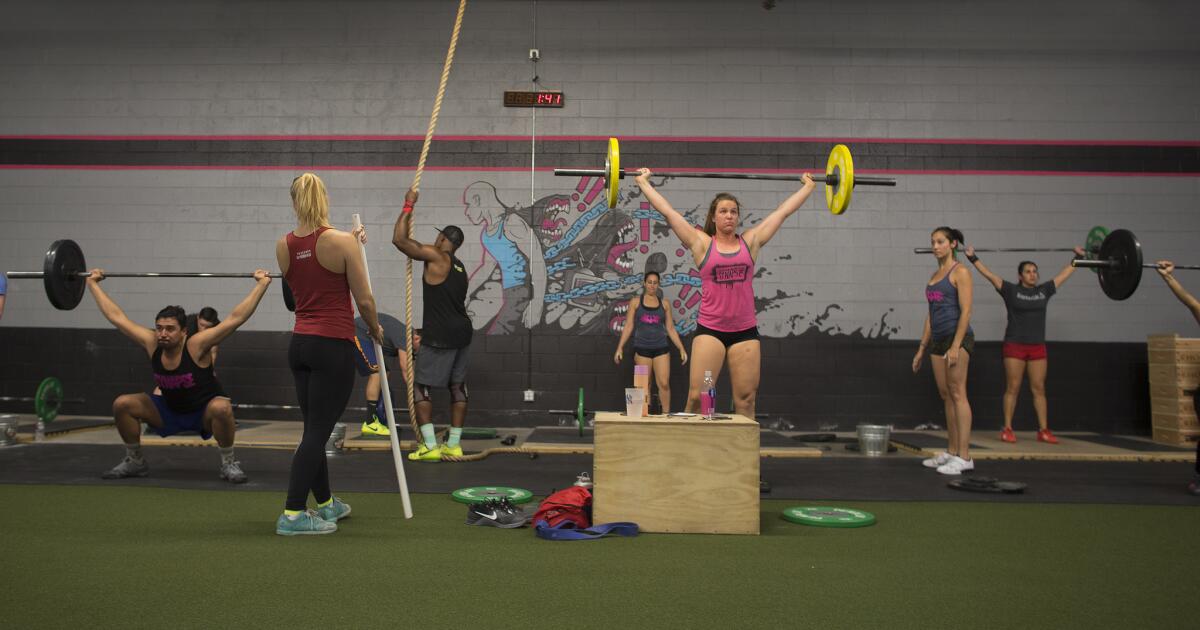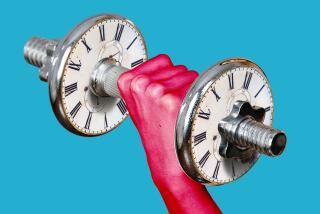Women find boost in ability and other benefits in strength training

Allison Truscheit, left, observes her clients while they practice barbell lifts.
- Share via
Francesca Guagliano likes the toned arms, the camaraderie and the thrill of competition that she gets from her twice-a-week strength-training classes at her gym, CrossFitLA in West Los Angeles. But most of all, she likes being able to carry the dog food.
“We joke about it,” says the 37-year-old Bel-Air mother of two. “Instead of having the bag boy drag the big bag of dog food out to the car for us, now we carry it out ourselves in one hand — with a heavy bag of groceries in the other.
“Women don’t need giant muscles. But to do functional stuff, we do need muscles.”
Tens of thousands of women, like Guagliano, have been introduced to push-ups, pull-ups, squats, dead-lifts, cleans and thrusters in the last decade through the country’s 8,000 CrossFit gyms, in which 60% of the clientele are female, according to CrossFit Games Executive Director Dave Castro. But the dog food message is only slowly getting out to the general population. Despite studies over the decades confirming that strength training ramps up metabolism, builds muscle and stronger connective tissue, and protects against osteoporosis, diabetes, arthritis, excess body fat and joint injuries for both sexes, and may benefit women even more because they start at a strength deficit, females have shunned it.
There are two reasons for that, according to Lyn Paul, a Montana State University Extension professor who studied the effect of weight training on 60- and 70-year-old rural women: the idea that strength is a guy thing, and the fear of becoming muscle-bound.
“Both of those are myths,” she says. “Strength is a necessity for everyone, and women lack the testosterone production to build man-size muscles, anyway. When women finally get around to a strength program, they find they love it. The leaner body, the shapelier curves, the group bonding. And most of all, the functionality.
“Yes, dog food comes up all the time. ‘Now I can lift the dog food out of the trunk,’ they say. ‘And now I can put luggage in the overhead bin without asking for help.’”
The aversion to strength starts early and is hard to shake. “As young girls, we become afraid of developing muscles,” says Allison Truscheit, who owns two CrossFit gyms in Tarzana and North Hollywood. “Our role models in magazines are either skinny supermodels or “real girls” — meaning fat. They aren’t muscular. As a coach, I found cheerleaders were the only girls I could get to weight train, because it helped them do their most fun thing: Lift the other girls over their head.”
“It takes years — into their 30s and 40s and 50s — before the goal becomes less what you look like and more of what you’re capable of.”
Regardless of age, women appear to gain a new confidence from strength training. “My study found that the No. 1 benefit of strength is that the enhanced function makes them feel empowered,” says Paul. “This whets their appetite for more strength, pushing them further down the health-and-fitness road.”
Some take their empowerment far beyond puppy chow and in-flight luggage. Julie Foley, 52, a 5-foot-2 mother of four from Tustin who was introduced to weightlifting three years ago while working out with her son at a 24-Hour Fitness, felt so empowered by achieving a150-pound dead-lift that she joined a powerlifting gym. Training three to five nights a week at the World of Weightlifting gym in Anaheim, run by renowned body builder and powerlifter Danny McDermott, she won gold medals in her 58-kilo (128-pound) weight class at the Pan Am Games in 2012 and 2014, and last year she set a deadlift world record of 249 pounds.
“Strength is gradually seeping into the consciousness of young women,” says Foley, who mentors several teens and preteens. “They see us moms at CrossFit gyms or doing powerlifting and see that you don’t turn into a big she-man.” In fact, since her weight training began, Foley dropped from a size 6 to a size 2 pant and from 131 pounds to 123. “But I’m so solid that I have a 26-inch waist and look like I weigh 115. And I’ve never felt better.”
The positive vibe starts with the first weight lifted, according to Jennifer Cohen, author of “Strong Is the New Skinny.” “Do something you never thought you could do, like three push-ups or a pull-up, and it creates a big change in you. It opens the door to other tasks. You want to jump higher, lift heavier, run faster.”
Or carry more luggage.


